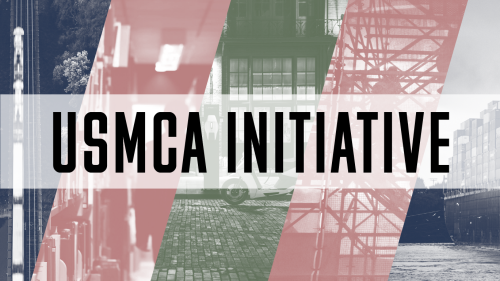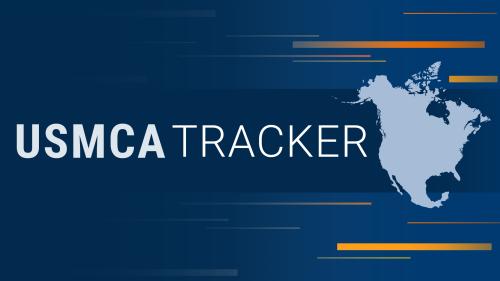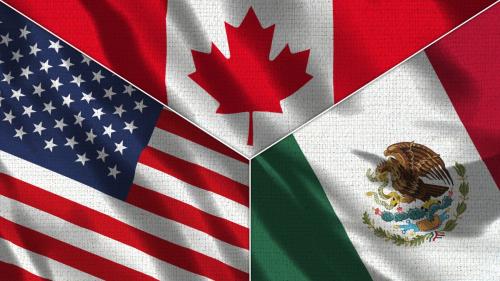2024


This report is the Brookings USMCA initiative’s third annual flagship publication. It takes stock of the state of the North American trade relationship and looks at how the three parties to the United States-Mexico-Canada Agreement (USMCA), including business and civil society, can further leverage USMCA to strengthen economic relations in the lead-up to the joint review in 2026.
Three key themes form the backdrop for maximizing the USMCA opportunity—and indicate where progress will be important:
We are honored this year to include chapters from prominent academics and other thought leaders as well as viewpoints from senior leaders in government, business, and civil society.
USMCA is the most important economic agreement in North America. This agreement provides the rules and stability that enable $1.8tn annually in trade. USMCA is also more than a trade agreement, it is an economic cooperation agreement that touches on how each government regulates and cooperates to build the industries and technologies of the future. Since USMCA came into effect in July 2020, the COVID-19 crisis, Russia’s invasion of Ukraine, and rising economic and strategic tensions with China have highlighted the need to make supply chains more resilient and to reduce risks arising from an overly close economic relationship with China. Indeed, the U.S. is already investing heavily in expanding production of clean energy and semiconductors, and Canada and Mexico are essential partners. Achieving these goals further highlights the importance of USMCA for building closer economic cooperation across North America that draws on the various resources, skills, and capacities across the three countries to build more competitive and resilient economies.
USMCA has already demonstrated its importance for North America. In 2022, the total value of trade within North America was equivalent to nearly $3 million per minute and the result of double-digit growth in trade over the past two years. As a result, Mexico and Canada are now the top trading partners of the United States, with trade volumes 44% higher than U.S. goods trade with China. Combined, the three countries now account for almost a third of global GDP, and intra-regional trade supports approximately 17 million jobs across North America.
The passage of USMCA through the legislatures of all three countries with overwhelming political support, including from the American Federation of Labor and Congress of Industrial Organizations (AFL-CIO), underscored that USMCA presents a new approach to economic relations. In particular, USMCA demonstrates how international trade and investment can strengthen labor standards and wages, drive growth in manufacturing, improve environmental outcomes, and increase opportunities for small businesses to grow and prosper. The USMCA’s new and binding rules on labor and environment, including the innovative rapid response mechanism (RRM) to address facility specific labor violations, have been key in proving that trade can coexist with and support strong social outcomes. The agreement’s tighter rules of origin for automobiles, the requirement that 40% of auto manufacturing comes from high wage factories, and that 70% of steel and aluminum used in cars come from North America, should also lead to more investment in manufacturing capacity in North America.
However, realizing USMCA’s potential requires ongoing attention and vision. The starting point must be compliance by all governments with their USMCA commitments, and in this regard all the governments fall short, as shown by the Brookings USMCA Tracker that scores each government’s compliance with their USMCA commitments. Second, maximizing economic opportunities for North America that builds on USMCA requires complementary policies, laws and investments. For example, North America needs even more integrated and efficient border infrastructure, better alignment of regulation, and greater investment in workforce training. Making this a reality requires leadership by government, but leaders in business and civil society must also play a role.
USMCA must recognize that we have a living and dynamic relationship under a predictable and certain agreement. To that end, we should enhance cooperation, and place particular emphasis on important areas and together, define working plans to maximize the potential of the trilateral relationship. Examples include the use of technology to enhance productivity (AI, machine learning and others), securing supplies of critical minerals needed to produce batteries that will underpin the enormously important transition to EVs, and deeper cooperation on climate change and clean energy.
The USMCA includes a requirement that by July 1, 2026, the three governments conduct a “joint review” of its operation, after which consensus is required to renew the agreement for another 16 years. Failure to renew, after annual joint reviews until 2036, if needed, would lead to the agreement’s termination. As such, it represents an important opportunity to determine what is working, what needs to be improved, and how to increase the region’s competitiveness, but we need to be clear that it is a review, not a renegotiation. Parties should not be using the review to change or influence dispute settlement outcomes or the content of the USMCA. This would turn it into a backward-looking discussion by seeking to undo what has already been agreed to.
Failure to agree to renew USMCA in 2026 will increase uncertainty and reduce trade and investment across North America. There is no need to incur these costs. Instead, all three governments should renew USMCA in 2026 and use the opportunity presented by the joint review to agree on a work program for updating USMCA with the goal of deepening economic cooperation across North America.
The Brookings USMCA initiative provides the data and analysis to clearly understand the importance of USMCA for North America. This includes the initiative’s USMCA Tracker that provides detailed data on trade and investment flows, as well as analysis and reports, including their flagship annual USMCA Forward report. In this year’s USMCA Forward 2024 report, analyses by subject matter experts and leaders from government, business, and civil society underscore the immense importance of USMCA for North America. The report makes clear that cooperation across North America among government, civil society, and business creates stronger economies that are more competitive and produce better outcomes for workers. As we cross the halfway point between the entry into force of the agreement in 2020 and the first USMCA review in 2026, this report provides a timely and important assessment of how USMCA has worked in key areas and what more could be done to make USMCA even more effective.
Going forward, leadership is required to build on the positive momentum in North American economic relations that USMCA underpins. First and foremost, renewal of USMCA in 2026 must be a priority and will send the strongest signal of government’s support for the agreement. Renewal will avoid unnecessary economic harm and lay the foundation for building a more competitive, sustainable, and inclusive North American economic relationship.
The USMCA can function as a guarantor of prosperity for North America for decades to come, a bulwark against the turmoil in much of the rest of the world and a beacon standing for peaceful, cooperative coexistence and friendship between our nations.

It has been three and a half years since USMCA was signed, ushering in a new era in North American economic cooperation. Joshua P. Meltzer and Brahima S. Coulibaly give an overview of how trade and investment have grown across North America and introduce the themes of this year’s report.

Mexico has the potential to boost its growth and development as it becomes a premier investment destination within North America. However, it must offer the best business environment, improve its labor productivity, develop the competitiveness of its local supply chain, and comply with USMCA commitments to take advantage of this opportunity, Luz María de la Mora explains.

María Eugenia Campos Galván
March 6, 2024

Judy Marks
March 6, 2024

The USMCA’s Facility-Specific Rapid Response Mechanism is the first of its kind, but it may not be the last. Kathleen Claussen examines the tool’s track record and offers procedural fixes to help it operate more smoothly.

Katherine Tai
March 6, 2024

The USMCA is not only about trade, cooperation on regulation, and investment. It is also an acknowledgment of political responsibility to the governed populations that extends beyond the economic and commercial spheres to include socio-cultural issues. Alfredo Domínguez Marrufo analyzes the agreement’s effects on labor relations in Mexico.

Liz Shuler
March 6, 2024

USMCA implementation is off to a good start. But achieving the agreement’s full potential depends on three additional factors: gaining traction on its cooperation chapters, developing the potential of its competitiveness committee, and leveraging parallel bilateral and trilateral mechanism. Former Ambassadors Louise Blais, Gerónimo Gutiérrez, and Earl Anthony Wayne break down the challenges and provide summary recommendations.

Roberto Velasco Álvarez
March 6, 2024

Beyond the special mechanism for labor complaints, the USMCA contains three types of dispute settlement mechanism: state-to-state, investor-state, and binational panel review. Robert Howse analyzes each and how they’ve changed since NAFTA.

Goldy Hyder
March 6, 2024

Suzanne P. Clark
March 6, 2024

U.S.-China trade tensions, supply chains disruptions, the war in Ukraine, and instability in the global order have underscored the value of the predictability offered by the USMCA. Oscar Ocampo considers ways to harness this revival of the “North American idea” for energy security, energy infrastructure development, and energy transition.

Jonathan Wilkinson
March 6, 2024

José Zozaya, Odracir Barquera
March 6, 2024

With growing digital trade, cross-border data transfers, and innovations like artificial intelligence, the countries of North America are beginning to take a greater role in regulating their digital economies. Alejandra Palacios and Christian Norton examine how the USMCA’s chapter on digital trade can help expand cooperation in digital spaces and avoid unnecessary restriction of data flows between countries.

Blanca Treviño
March 6, 2024

On July 1, 2026, the U.S., Mexico, and Canada will confirm in writing whether or not to continue the USMCA. If used as intended, the joint review can be a productive process that aims at keeping the agreement up-to-date. A smooth renewal in 2026, in addition to a work plan for addressing new issues in the USMCA, would avoid the uncertainty and economic costs that failure to renew would bring. Joshua P. Meltzer and Steve Verheul consider the origins of this review clause and how it may unfold.
Watch the launch event
2024
The Brookings Institution, Washington DC
12:30 pm - 2:30 pm EST
The Brookings Institution is a nonprofit organization devoted to independent research and policy solutions. Its mission is to conduct high-quality, independent research, and based on that research, provide innovative, practical recommendations for policymakers and the public. The conclusions and recommendations of any Brookings publication are solely those of its author(s), and do not reflect the views of the Institution, its management, or its scholars.
The editors would like to thank Brookings Trustee Paul Desmarais, Brookings International Advisory Council member Pablo González, and Patrick Ottensmeyer for their foundational support for the USMCA initiative. The initiative gratefully acknowledges the support of donors including but not limited to the three co-chairs, BNSF Railway, Canadian Pacific Kansas City Limited, CIBC, Consejo Mexicano de Negocios, A.C., and the Greenbrier Companies. In addition, General Motors and Morgan Stanley, corporations referenced in the report, are also donors to the Brookings Institution.
Brookings recognizes that the value it provides is in its absolute commitment to quality, independence, and impact. Activities supported by its donors reflect this commitment, and the analysis and recommendations are not determined or influenced by any donation. A full list of contributors to the Brookings Institution can be found in the Annual Report.

Measuring the effectiveness and implementation of the USMCA, as well as its impact on the policies and economies of the partner nations through forward-looking research, data, and analyses

Explore the latest data on trade, investments, meetings, and trade disputes

Reflections on the impact of the U.S.-Mexico-Canada Agreement upon its three-year anniversary